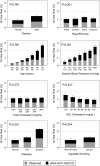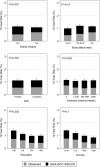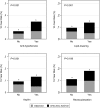Risk score overestimation: the impact of individual cardiovascular risk factors and preventive therapies on the performance of the American Heart Association-American College of Cardiology-Atherosclerotic Cardiovascular Disease risk score in a modern multi-ethnic cohort
- PMID: 27436865
- PMCID: PMC5837662
- DOI: 10.1093/eurheartj/ehw301
Risk score overestimation: the impact of individual cardiovascular risk factors and preventive therapies on the performance of the American Heart Association-American College of Cardiology-Atherosclerotic Cardiovascular Disease risk score in a modern multi-ethnic cohort
Abstract
Aims: To evaluate the 2013 American Heart Association (AHA)-American College of Cardiology (ACC)-Atherosclerotic Cardiovascular Disease (ASCVD) risk score among four different race/ethnic groups and to ascertain which factors are most associated with risk overestimation by the AHA-ACC-ASCVD score.
Methods and results: The Multi-Ethnic Study of Atherosclerosis (MESA), a prospective community-based cohort, was used to examine calibration and discrimination of the AHA-ACC-ASCVD risk score in 6441 White, Black, Chinese, and Hispanic Americans (aged 45-79 years and free of known ASCVD at baseline). Using univariable and multivariable absolute risk regression, we modelled the impact of individual risk factors on the discordance between observed and predicted 10-year ASCVD risk. Overestimation was observed in all race/ethnic groups in MESA and was highest among Chinese (252% for women and 314% for men) and lowest in White women (72%) and Hispanic men (67%). Higher age, Chinese race/ethnicity (when compared with White), systolic blood pressure (treated and untreated), diabetes, alcohol use, exercise, lipid-lowering medication, and aspirin use were all associated with more risk overestimation, whereas family history was associated with less risk overestimation in a multivariable model (all P < 0.05).
Conclusion: The AHA-ACC-ASCVD risk score overestimates ASCVD risk among men, women, and all four race/ethnic groups evaluated in a modern American primary prevention cohort. Clinicians treating patients similar to those in MESA, particularly older individuals and those with factors associated with more risk overestimation, may consider interpreting absolute ASCVD risk estimates with caution.
Keywords: Cardiovascular risk prediction; Prevention; Risk factors.
Published on behalf of the European Society of Cardiology. All rights reserved. © The Author 2016. For permissions please email: journals.permissions@oup.com.
Figures



Similar articles
-
Prevalence and Trends in Cardiovascular Risk Factors Among Middle Aged Persons from Five Race and Ethnic Groups in the United States: A Longitudinal Analysis of Two Cohort Studies.medRxiv [Preprint]. 2024 Sep 28:2024.09.27.24314520. doi: 10.1101/2024.09.27.24314520. medRxiv. 2024. PMID: 39399001 Free PMC article. Preprint.
-
Comparison of Two Modern Survival Prediction Tools, SORG-MLA and METSSS, in Patients With Symptomatic Long-bone Metastases Who Underwent Local Treatment With Surgery Followed by Radiotherapy and With Radiotherapy Alone.Clin Orthop Relat Res. 2024 Dec 1;482(12):2193-2208. doi: 10.1097/CORR.0000000000003185. Epub 2024 Jul 23. Clin Orthop Relat Res. 2024. PMID: 39051924
-
Applicability and Risk Stratification of QRISK®, Framingham Risk Score, Systematic Coronary Risk Evaluation (SCORE), and American College of Cardiology/American Heart Association (ACC/AHA) Risk Assessment Tools Among Patients in Taif, Saudi Arabia.Cureus. 2025 Jun 28;17(6):e86910. doi: 10.7759/cureus.86910. eCollection 2025 Jun. Cureus. 2025. PMID: 40726871 Free PMC article.
-
Behavioral interventions to reduce risk for sexual transmission of HIV among men who have sex with men.Cochrane Database Syst Rev. 2008 Jul 16;(3):CD001230. doi: 10.1002/14651858.CD001230.pub2. Cochrane Database Syst Rev. 2008. PMID: 18646068
-
Fixed-dose combination therapy for the prevention of atherosclerotic cardiovascular diseases.Cochrane Database Syst Rev. 2017 Mar 6;3(3):CD009868. doi: 10.1002/14651858.CD009868.pub3. Cochrane Database Syst Rev. 2017. PMID: 28263370 Free PMC article.
Cited by
-
EXIST: EXamining rIsk of excesS adiposiTy-Machine learning to predict obesity-related complications.Obes Sci Pract. 2023 Sep 13;10(1):e707. doi: 10.1002/osp4.707. eCollection 2024 Feb. Obes Sci Pract. 2023. PMID: 38264008 Free PMC article.
-
Assessing Atherosclerotic Cardiovascular Disease Risk with Advanced Lipid Testing: State of the Science.Eur Cardiol. 2020 Jul 15;15:e56. doi: 10.15420/ecr.2019.18. eCollection 2020 Feb. Eur Cardiol. 2020. PMID: 32742310 Free PMC article. Review.
-
Blood-Based Biomarkers for Predicting the Risk for Five-Year Incident Coronary Heart Disease in the Framingham Heart Study via Machine Learning.Genes (Basel). 2018 Dec 18;9(12):641. doi: 10.3390/genes9120641. Genes (Basel). 2018. PMID: 30567402 Free PMC article.
-
Association between Blood Heavy Metal Levels and Predicted 10-Year Risk for A First Atherosclerosis Cardiovascular Disease in the General Korean Population.Int J Environ Res Public Health. 2020 Mar 23;17(6):2134. doi: 10.3390/ijerph17062134. Int J Environ Res Public Health. 2020. PMID: 32210108 Free PMC article.
-
Coronary Artery Calcium Scoring in Current Clinical Practice: How to Define Its Value?Curr Treat Options Cardiovasc Med. 2017 Sep 25;19(11):85. doi: 10.1007/s11936-017-0582-y. Curr Treat Options Cardiovasc Med. 2017. PMID: 28948466 Review.
References
-
- Goff DC Jr, Lloyd-Jones DM, Bennett G, Coady S, D'Agostino RB, Gibbons R, Greenland P, Lackland DT, Levy D, O'Donnell CJ, Robinson JG, Schwartz JS, Shero ST, Smith SC Jr, Sorlie P, Stone NJ, Wilson PW, Jordan HS, Nevo L, Wnek J, Anderson JL, Halperin JL, Albert NM, Bozkurt B, Brindis RG, Curtis LH, DeMets D, Hochman JS, Kovacs RJ, Ohman EM, Pressler SJ, Sellke FW, Shen WK, Smith SC Jr, Tomaselli GF. 2013 ACC/AHA guideline on the assessment of cardiovascular risk: a report of the American College of Cardiology/American Heart Association Task Force on Practice Guidelines. Circulation 2014;129(Suppl. 2):S49–S73. - PubMed
-
- Fried LP, Borhani NO, Enright P, Furberg CD, Gardin JM, Kronmal RA, Kuller LH, Manolio TA, Mittelmark MB, Newman A, O'Leary DH, Psaty B, Rautaharju P, Tracy RP, Weiler PG. The Cardiovascular Health Study: design and rationale. Ann Epidemiol 1991;1:263–276. - PubMed
-
- Friedman GD, Cutter GR, Donahue RP, Hughes GH, Hulley SB, Jacobs DR Jr, Liu K, Savage PJ. CARDIA: study design, recruitment, and some characteristics of the examined subjects. J Clin Epidemiol 1988;41:1105–1116. - PubMed
-
- Investigators TA. The Atherosclerosis Risk in Communities (ARIC) Study: design and objectives. Am J Epidemiol 1989;129:687–702. - PubMed
Publication types
MeSH terms
Grants and funding
- N01 HC095161/HL/NHLBI NIH HHS/United States
- N01 HC095168/HL/NHLBI NIH HHS/United States
- N01 HC095167/HL/NHLBI NIH HHS/United States
- N01 HC095159/HL/NHLBI NIH HHS/United States
- N01 HC095163/HL/NHLBI NIH HHS/United States
- UL1 TR000040/TR/NCATS NIH HHS/United States
- N01 HC095166/HL/NHLBI NIH HHS/United States
- N01 HC095162/HL/NHLBI NIH HHS/United States
- N01 HC095160/HL/NHLBI NIH HHS/United States
- UL1 TR001079/TR/NCATS NIH HHS/United States
- N01 HC095169/HL/NHLBI NIH HHS/United States
- N01 HC095165/HL/NHLBI NIH HHS/United States
- N01 HC095164/HL/NHLBI NIH HHS/United States
LinkOut - more resources
Full Text Sources
Other Literature Sources
Medical

